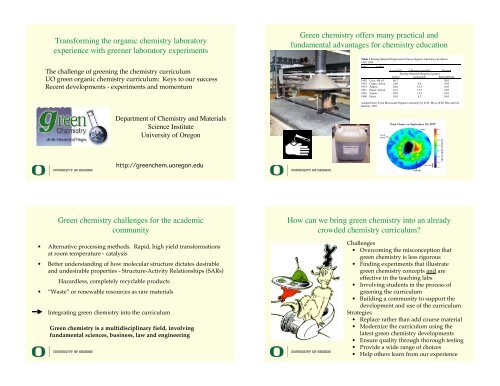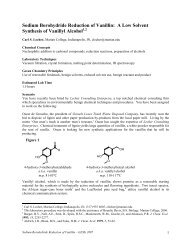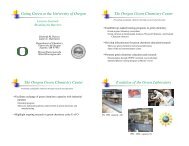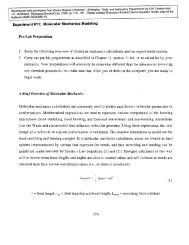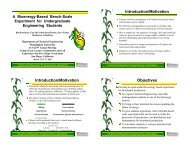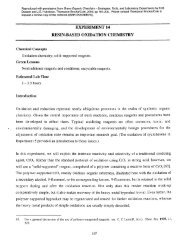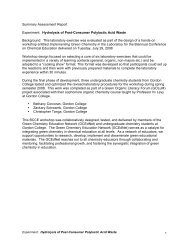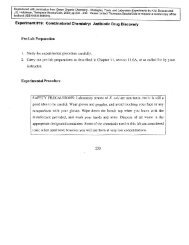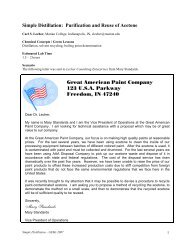Power Point Presentation (PDF) - Green Chemistry Center
Power Point Presentation (PDF) - Green Chemistry Center
Power Point Presentation (PDF) - Green Chemistry Center
Create successful ePaper yourself
Turn your PDF publications into a flip-book with our unique Google optimized e-Paper software.
Transforming the organic chemistry laboratory<br />
experience with greener laboratory experiments<br />
The challenge of greening the chemistry curriculum<br />
UO green organic chemistry curriculum: Keys to our success<br />
Recent developments - experiments and momentum<br />
<strong>Green</strong> chemistry offers many practical and<br />
fundamental advantages for chemistry education<br />
Table 1 Starting Material Employed in Classic Organic Laboratory Syntheses<br />
1902-1980<br />
Date Author<br />
Acetanilide 4-Bromoacetanilide Benzoin<br />
Starting Materials Required (grams)<br />
Aniline Acetanilide Benzaldehyde<br />
1902 Levy, 4th ed. 46.2 50.0<br />
1915 Cohen, 3rd ed. 25.0 5.0 25.0<br />
1933 Adkins 28.0 13.5 10.0<br />
1941 Fieser, 2nd ed. 18.2 13.5 25.0<br />
1963 Adams 20.0 13.5 16.0<br />
1980 Drust 10.0 5.2 10.0<br />
Adapted from: From Microscale Organic Laboratory by D.W. Mayo, R.M. Pike and S.S.<br />
Butcher, 1985<br />
Department of <strong>Chemistry</strong> and Materials<br />
Science Institute<br />
University of Oregon<br />
http://greenchem.uoregon.edu<br />
<strong>Green</strong> chemistry challenges for the academic<br />
community<br />
• Alternative processing methods. Rapid, high yield transformations<br />
at room temperature - catalysis<br />
• Better understanding of how molecular structure dictates desirable<br />
and undesirable properties - Structure-Activity Relationships (SARs)<br />
Hazardless, completely recyclable products<br />
• “Waste” or renewable resources as raw materials<br />
• Integrating green chemistry into the curriculum<br />
<strong>Green</strong> chemistry is a multidisciplinary field, involving<br />
fundamental sciences, business, law and engineering<br />
How can we bring green chemistry into an already<br />
crowded chemistry curriculum?<br />
Challenges<br />
• Overcoming the misconception that<br />
green chemistry is less rigorous<br />
• Finding experiments that illustrate<br />
green chemistry concepts and are<br />
effective in the teaching labs<br />
• Involving students in the process of<br />
greening the curriculum<br />
• Building a community to support the<br />
development and use of the curriculum<br />
Strategies<br />
• Replace rather than add course material<br />
• Modernize the curriculum using the<br />
latest green chemistry developments<br />
• Ensure quality through thorough testing<br />
• Provide a wide range of choices<br />
• Help others learn from our experience
Process used to develop and teach greener<br />
laboratory procedures<br />
Assess existing<br />
procedure<br />
Identify hazards<br />
or inefficiencies<br />
Find/develop<br />
alternative methods<br />
Test efficacy<br />
of new procedure<br />
TRADITIONAL<br />
H<br />
GREENER<br />
H<br />
A safer bromination of an olefin<br />
H<br />
Br H<br />
+<br />
CCl<br />
Br 4 or CH 2Cl 2<br />
2<br />
H<br />
1. HBr<br />
2. 30% H 2 O 2<br />
ethanol, reflux<br />
H<br />
H Br H<br />
ethanol<br />
H<br />
GREEN<br />
ethanol<br />
N H Br 3<br />
N H Br + Br 2<br />
H<br />
Br<br />
Br<br />
We teach this simple process to<br />
our students as we implement it.<br />
<strong>Green</strong>er<br />
alternative<br />
Laboratory Skills:<br />
<strong>Green</strong> Lessons Taught:<br />
Reaction set-up<br />
Less toxic solvents can be selected<br />
Vacuum filtration<br />
Hazardous reagents can be generated in situ<br />
Melting point determination<br />
Djerassi, C; Scholz, C.R. J. Am. Chem. Soc. 1948, 70, 417.<br />
Reed, S.M.; Hutchison, J.E. J. Chem. Ed. 2000, 77, 1627-1629.<br />
McKenzie, L. C.; Huffman, L. M.; Hutchison, J. E. J. Chem. Ed. 2005, 82, 306-310.<br />
Analysis using green metrics<br />
• Appropriate metrics for teaching laboratories:<br />
– Enhance student safety<br />
– Reduce the volume and hazard of the wastestream<br />
– Ease reliance on environmental controls<br />
– Improve reaction efficiency<br />
• Atom economy, percent experimental atom<br />
economy, E factor, effective mass yield<br />
McKenzie, L. C.; Huffman, L. M.; Hutchison, J. E. "The evolution of a green<br />
chemistry laboratory experiment greener brominations of stilbene," Journal of<br />
Chemical Education 2005, 82, 306-310.<br />
O<br />
Solventless Aldol Condensation<br />
mp 40-42 oCmp 42-45 oCmp 178 - 181 ° C<br />
Chemical Concepts:<br />
Melting point determination<br />
and depression<br />
Aldol condensation reaction<br />
Recrystallization skills<br />
+<br />
O<br />
1. NaOH<br />
2. H 3 O + workup<br />
OCH 3<br />
OCH 3<br />
H 3 CO OCH 3<br />
<strong>Green</strong> Lessons:<br />
Solventless reactions<br />
Atom economical reactions<br />
Rothenberg, G.; Downie, A. P.; Raston, C. L.; Scott, J. L.<br />
J. Am. Chem. Soc. 2001, 123, 8701-8708.<br />
Raston, C. L.; Scott, J. L. <strong>Green</strong> <strong>Chemistry</strong> 2000, 2, 49-52.<br />
O
Liquid CO 2 as a green extraction solvent<br />
Liquid CO 2 extraction in the teaching laboratory<br />
Traditional Method<br />
Orange Peel<br />
<strong>Green</strong> Method<br />
Orange Peel<br />
Steam distill<br />
and/or<br />
Organic solvent<br />
CO 2 (liquid)<br />
No organic solvent<br />
D-limonene<br />
Chemical Concepts:<br />
Solid/liquid extraction<br />
Natural products (terpenes)<br />
Spectroscopy<br />
Phase transitions<br />
<strong>Green</strong> Lessons:<br />
Use of safer solvents<br />
Prevention of waste<br />
<strong>Green</strong> materials processing<br />
McKenzie, L. C.; Thompson, J. E.; Sullivan, R.; Hutchison, J. E. "<strong>Green</strong><br />
chemical processing in the teaching laboratory: A convenient liquid CO 2<br />
extraction of natural products," <strong>Green</strong> Chem. 2004, 355-358.<br />
<strong>Green</strong> Organic <strong>Chemistry</strong> Laboratory Manual<br />
Target audience: Sophomore-level organic<br />
chemistry laboratory<br />
• Introduction<br />
• Identification of Chemical Hazards<br />
• Chemical Exposure and<br />
Environmental Contamination<br />
• Evaluation of Chemical Hazards<br />
• Introduction to <strong>Green</strong> <strong>Chemistry</strong><br />
• Alternative Solvents<br />
• Alternative Reagents<br />
• Reaction Design and Efficiency<br />
• Alternative Feedstocks and Products<br />
Plus 19 <strong>Green</strong> Organic <strong>Chemistry</strong> Experiments<br />
Laboratory curriculum project implementation<br />
250<br />
200<br />
150<br />
100<br />
Fall term 2003<br />
Synthesis, separations, spectroscopy<br />
1. Solventless Aldol condensation<br />
2. Bromination of an alkene<br />
3. Preparation/distillation of<br />
cyclohexene<br />
4. Synthesis of adipic acid<br />
5. Oxidative coupling of alkynes<br />
6. Gas phase porphyrin synthesis<br />
7. Solvent effects on kinetics<br />
8. Molecular mechanics modeling<br />
50<br />
0<br />
97-<br />
98<br />
98-<br />
99<br />
99-<br />
00<br />
00-<br />
01<br />
01-<br />
02<br />
04-<br />
05<br />
Number of<br />
Students<br />
Winter term 2004<br />
Synthesis, spectroscopy, applications<br />
1. Electrophilic iodination with KI/NaOCl<br />
2. Palladium-catalyzed aryl halide/alkyne<br />
coupling<br />
3. Polymer-supported oxidation chemistry<br />
4. Friedel-Crafts acylation of ferrocene<br />
5. Thiamine-mediated benzoin condensation<br />
6. Self-assembled monolayers/patterning<br />
7. Combinatorial synthesis of antibiotics
The approach changes the way students think about<br />
chemical hazards and chemistry<br />
"After taking this course I have a much better opinion of chemistry .... I feel like<br />
I am learning something that has an actual important application to the real<br />
world."<br />
"I have decided to get a minor in chemistry so I can make more conscious<br />
decisions regarding chemistry and avoid destructive practices for my health or<br />
the environment."<br />
• Teaches students a rational procedure for analyzing/minimizing<br />
hazards<br />
• Empowers students to use chemistry to solve environmental<br />
problems - "Ambassadors of <strong>Green</strong> <strong>Chemistry</strong>"<br />
• Changes the way students and society view chemicals, chemistry<br />
and chemists - "Know the hazards, not all chemicals are hazardous"<br />
Our experience introducing green chemistry - there<br />
are many incentives<br />
We are generating less waste and a less hazardous waste stream.<br />
Winter term disposal numbers (14.2L of aqueous, 1L of flammable<br />
organic and 1kg of solid waste for 180 students)<br />
The project has been great for University public relations<br />
More than 20 articles have now been published around the world<br />
Enhances student recruiting<br />
We have seen strong interest from undergrads and grads who want to<br />
be part of green chemistry<br />
Opportunity to upgrade curriculum and facilities<br />
University invested in a showcase lab facility to highlight the program<br />
Improved educational atmosphere<br />
The new lab setting is an excellent learning environment<br />
The new green chemistry lab<br />
<strong>Green</strong> chemistry offers many practical and<br />
fundamental advantages for chemistry education<br />
Table 1 Starting Material Employed in Classic Organic Laboratory Syntheses<br />
1902-1980<br />
Date Author<br />
Acetanilide 4-Bromoacetanilide Benzoin<br />
Starting Materials Required (grams)<br />
Aniline Acetanilide Benzaldehyde<br />
1902 Levy, 4th ed. 46.2 50.0<br />
1915 Cohen, 3rd ed. 25.0 5.0 25.0<br />
1933 Adkins 28.0 13.5 10.0<br />
1941 Fieser, 2nd ed. 18.2 13.5 25.0<br />
1963 Adams 20.0 13.5 16.0<br />
1980 Drust 10.0 5.2 10.0<br />
Adapted from: From Microscale Organic Laboratory by D.W. Mayo, R.M. Pike and S.S.<br />
Butcher, 1985
Next steps<br />
More labs!<br />
Disseminate our and other’s labs via the GEMs<br />
database<br />
Promote the community through workshops,<br />
symposia and collaborations<br />
Build the “business case” for green chemistry<br />
Workshop participants 2001-present<br />
Addressing the case for green chemistry<br />
“<strong>Green</strong> chemistry will be more expensive”<br />
Must carefully consider costs of reagents, solvents, disposal, engineering<br />
controls, new labs, etc.<br />
“There are no lab exercises available and I don’t have time to develop my own”<br />
A wide range of experiments are now in development around the<br />
country. There should be a lot of choice soon.<br />
“There is no room in the curriculum for new material”<br />
Don’t add, replace.<br />
“The curriculum will not train students to work with hazardous materials”<br />
Most students will not work with hazardous substances after organic.<br />
Don’t have to work with hazardous substances to learn proper technique.<br />
“<strong>Green</strong> is political, not scientific…green chemistry is not rigorous”<br />
Designing better products and better processes is what synthetic chemists<br />
do. <strong>Green</strong> chemistry provides a new challenge.
Acknowledgments<br />
Prof. Ken Doxsee<br />
Dr. Scott Reed<br />
Ms. Lallie McKenzie<br />
Mr. Marvin Warner<br />
Ms. Lauren Huffman<br />
Dr. Julie Haack<br />
Dr. Rob Gilbertson<br />
Mr. Gary Succaw<br />
Dr. John Thompson<br />
Ms. Kathryn Parent<br />
Ms. Anna Shope<br />
Dr. Leif Brown<br />
Mr. Gerd Woehrle<br />
and the Students of CH337G and CH338G<br />
The Alice C. Tyler Perpetual Trust<br />
The University of Oregon


